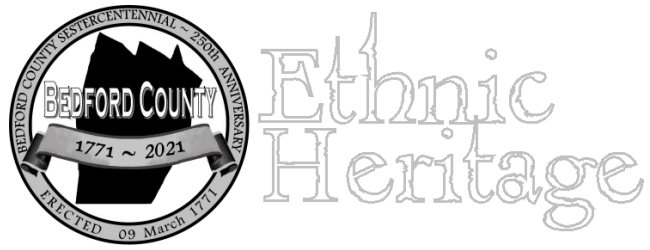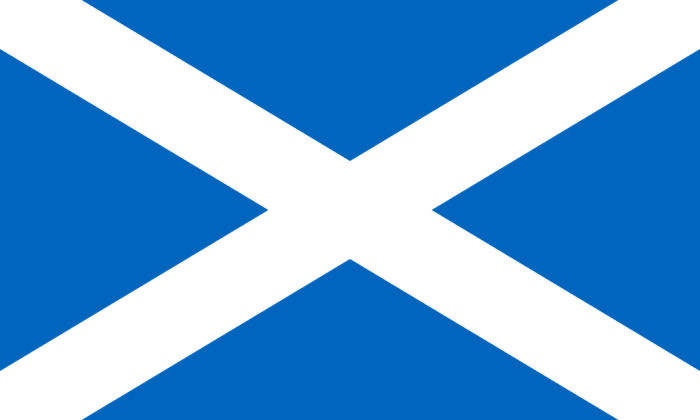
Scottish~American Day
06 April 2021

The American Community Survey, compiled between 2008 and 2012 and being the most recent analysis, identified 1% of the total population of Bedford County as descending from Scottish ancestors.
This day is known as National Tartan Day. It celebrates the signing of the Declaration of Arbroath in 1320. The Declaration was sent to Pope John XXII in an attempt to obtain his assistance in pressuring England to end its war of aggression against Scotland. The document, which was originally composed simply as a letter requesting the Pope's aid. It has come to represent a declaration that Scotland deserved to be an independent and sovereign nation, despite the fact that that exact wording does not appear on the document. To Scots worldwide, the Declaration of Arbroath is equivalent to the Declaration of Independence issued by the Colonial Patriots in 1776.
The first Scotsman to emigrate from Scotland to find a new life in the North American continent was Robert Sproat. He sailed on the Mayflower in 1620. In 1717, the British Parliament passed the Transportation Act which called for the deportation of Scottish Jacobite rebels to the British Colonies in North America. Other Scotsmen poured into the North American colonies for two decades prior to the American Revolution. Many of them would express their dislike of England by espousing the Patriot Cause. Nearly half of the signers of the Declaration of Independence in 1776 were of Scottish descent. As already noted, the American Declaration of Independence was partly modeled on the Declaration of Arbroath.
The observance of the day as a holiday was started in Canada in April 1987 when it was proclaimed as such by Nova Scotia. It had been suggested by the Federation of Scottish Clans during the meeting held in Nova Scotia on 9 March 1986. In 1991 the Ontario Legislature also proclaimed the day as a holiday. In the United States, the Scottish Coalition USA lobbied Congress in 1997 to follow Canada's lead and adopt a National Tartan Day. The U.S. Senate passed a resolution declaring the day as a holiday in 1998.
The text of Senate Resolution 155, submitted by Senator Trent Lott and passed on 20 March 1998 read as follows: "S. RES. 155 Whereas April 6 has a special significance for all Americans, and especially those Americans of Scottish descent, because the Declaration of Arbroath, the Scottish Declaration of Independence, was signed on April 6, 1320 and the American Declaration of Independence was modeled on that inspirational document; Whereas this resolution honors the major role that Scottish Americans played in the founding of this Nation, such as the fact that almost half of the signers of the Declaration of Independence were of Scottish descent, the Governors in 9 of the original 13 States were of Scottish ancestry, Scottish Americans successfully helped shape this country in its formative years and guide this Nation through its most troubled times; Whereas this resolution recognizes the monumental achievements and invaluable contributions made by Scottish Americans that have led to America's preeminence in the fields of science, technology, medicine, government, politics, economics, architecture, literature, media, and visual and performing arts; Whereas this resolution commends the more than 200 organizations throughout the United States that honor Scottish heritage, tradition, and culture, representing the hundreds of thousands of Americans of Scottish descent, residing in every State, who already have made the observance of Tartan Day on April 6 a success; and Whereas these numerous individuals, clans, societies, clubs, and fraternal organizations do not let the great contributions of the Scottish people go unnoticed: Now, therefore, be it Resolved, That the Senate designates April 6 of each year as 'National Tartan Day'."
The establishment of national holidays celebrating the 6th of April as Tartan Day spread throughout the Scottish Diaspora from the 1990s through the early years of the 21st Century. The Scottish Diaspora includes (in descending rates of population) the United States, Canada, Australia, England, Argentina, Chile, France, Poland, New Zealand, South Africa, Isle of Man, Hong Kong and Brazil. Scotland, herself, got around to establishing National Tartan Day in 2004.
Tartan Day is widely celebrated in the United States because of the great numbers of people of Scottish descent. In some locations, athletes compete in what are called 'Highland Games.' Activities include tossing the caber, a long log; the stone put, throwing a stone weighing twenty to twenty-six pounds; the hammer throw, a sixteen to twenty-two pound ball attached to a four feet long handle; and no doubt a crowd favorite: the sheaf toss, the hefting over a raised bar of a twenty pound bundle of straw with a pitchfork. In just about all locations, whether there are highland games or not, Scottish~Americans enjoy bagpipe music and feasting on traditional Scottish foods. The Tartan Day Parade held in New York City is one of the largest events held in the United States where you can certainly get your fill of bagpipe music. Marching in traditional Scottish kilts are nearly 1,500 pipers and drummers along with ladies dancing traditional Scottish dances such as the ceilidh.
One of the most unique aspects of Scottish pride is visible in the Scots' love of tartan. Tartan is essentially a material woven in a particular plaid pattern. Patterns that were unique to a specific region eventually became associated with family clans, perhaps because of a prevalence of particular families in particular geographic regions. What is seen on National Tartan Day are people of Scottish descent who love wearing clothes in traditional tartan. And on that day it is not uncommon to see men donning kilts.
Tartan Day dinners consist of many dishes that non-Scottish~Americans have probably heard of but never tried. Haggis has got to be the most famous of all Scottish foods, but it is probably a safe bet that most people have never tried it ~ at least in its authentic form. That is because it has been illegal in the United States since 1971. The USDA has banned authentic haggis because its ingredients include sheep lungs. In addition to the lungs, the sheep's liver, heart and tongue would be diced up and mixed with oatmeal, minced onion, suet and spices all stuffed in a sheep's stomach, or sausage casing, and boiled. The result is a very spicy sausage-like dish. Haggis is often paired with 'Neeps and Tatties' which are the names for turnips and potatoes. The turnip used in neeps and tatties is more accurately the rutabaga, or white turnip. Neeps and Tatties are easy to prepare. You boil an equal amount of potatoes and rutabagas until tender and then mash them till they're smooth. Diced scallions, mustard, pepper and butter are stirred into the mixture. Rumbledethumps is another baked dish consisting of potatoes and rutabagas. It also contains cabbage and onions. The potatoes and rutabagas are cooked till tender, then the cabbage and onions are added and the cooking is continued until they are tender. The mix is mashed and then topped with grated cheddar cheese. Stovies is a dish made up of roast and minced meat mixed with potatoes somewhat on the order of corned beef hash. Stovies has traditionally been slow-stewed and modern cooks most often prepare it in a crock-pot.
Cock-a-leekie soup, is a soup consisting of peppered-chicken stock thickened with rice or barley and to which leeks are added. The dish is believed to have originated as chicken and onion soup in France and taken to Scotland in the Sixteenth Century. Another kind of soup or stew, Scotch broth is composed of lamb or mutton (sometimes beef) along with root vegetables and barley. The 'secret ingredient' of Scotch broth is any type of 'pulse' or legumes, such as beans or chick peas.
To go along with the various soups is Bannock, a type of flat bread. Bannock is sometimes called 'skillet bread' because it is prepared in a skillet from unsweetened oat or barley flour. Lard or shortening is added to the flour and stirred together until it forms lumps. Some of the lumps are placed in a heated skillet and a little bit of water is added to it to form a thick batter. The batter is then baked until the top is golden brown. The loaf is flipped and baked until the other side turns a golden brown. When finished baking, the loaf of bannock is flat with a firm, crusty outside and a soft, flaky inside.
Scotland, being a sea-bound country, has many dishes using fish or other seafood as its main ingredient. Kippered herring also known simply as Kippers is a form of smoke-cured whole herring. It is known around the world and usually eaten cold. Kippered herring is commonly sold today as precooked filets in small tin containers. Less well known might be 'Finnan haddie' which is cold-smoked haddock that is roasted or grilled. It is sometimes used in fish-based soups, such as Cullen skink which is finnan haddie boiled with potatoes and onions. Crappit heid is a boiled fish head traditionally stuffed with liver, suet and oats, or variously fish roe or lobster. The stuffed heads are then simmered for an hour in water or fish stock.
Oatmeal was noted earlier as an ingredient in other dishes, but oatmeal has always had a special place in the hearts of Scots. Porridge is simply oatmeal mixed with water and a dash of salt and cooked, but in Scotland the preparation of Scottish porridge takes on an appearance of ceremony. One and one-half of oatmeal is mixed with three cups of water and a pinch of salt. The water should be added to a pot and brought to a boil, then reduced to medium heat. Then the oatmeal is sprinkled in. As the oatmeal soaks up the water, it should be stirred. It must be stirred, not with a metal spoon, but with a spurtle, a wooden spatula. The ingredients are stirred with the right hand and in a clockwise motion ~ otherwise the Devil will pay you a visit! As the oatmeal is stirred, the heat is again raised so that it again comes to a boil. As soon as it begins to boil again, the heat is reduced. The pinch of salt is added and stirred into the mixture. Then the pot should be covered for between twenty or thirty minutes. The porridge should be stirred (clockwise, of course) every now and then so as to prevent it sticking to the pot. The longer it is cooked, the creamier it will become. Scottish porridge is traditionally eaten in wooden bowls and it is best to eat it standing up. It might be noted that if you add more water to the mixture it will indeed become watery and you will not have porridge; you will have a pot of gruel.
Desert might take the form of Clootie dumplings. Variously known as Clootie pudding, the dish is prepared like a plum pudding. The dish gets its name from the 'cloot' or cloth in which it is wrapped to be cooked. Flour, oatmeal and suet is mixed with treacle, for which corn syrup may be substituted, along with milk, eggs, baking powder, cinnamon and raisins and currants to form a dough. The dough is formed into a ball and then placed in the center of a piece of cloth whose corners are gathered together and tied. The ball is placed in a pot of water and simmered for three hours. The result is a traditional pudding that is sprinkled with powdered sugar and eaten with custard or ice cream.
In reviewing the traditional Scottish foods, we must not leave without noting the beverage that is symbolic of Scottish heritage ~ Whisky. Malt barley or other grain was distilled into alcohol to produce whisky. In the United States the whisky made in Scotland is often referred to as Scotch. What is unique, and immediately noticeable, about Scottish whisky is that the name is spelled without the 'e' between the 'k' and the 'y'. Scotland's heritage of using their unique spelling has developed into an entitlement in which it is understood by all whiskey distillers that only the alcoholic beverage produced in Scotland may use that spelling of the name. All other producers respect Scotland's prerogative and out of that respect use the 'whiskey' spelling.
Additional Information Might Be Added Here. Please Check Back.
Click on this logo to return to the Calendar page.

